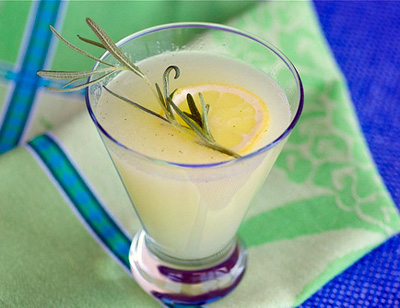 It's almost the end of summer, which likely means you're sunburned, overtired, and ready for your kids to go back to school. I'm here to help. Are you ready for some relaxation? Here's what you need to do:
It's almost the end of summer, which likely means you're sunburned, overtired, and ready for your kids to go back to school. I'm here to help. Are you ready for some relaxation? Here's what you need to do:
1. Make a batch of this Sparkling Rosemary-Ginger Lemonade and refrigerate it. Chill a tall glass in the freezer, and fill it with the ginger lemonade.
2. Find a comfy hammock or chaise lounge, preferably in a shady spot. Recline on it while sipping your ginger lemonade.
3. Tell your significant other, your kids, the dog to leave you alone. OK, maybe not the dog.
4. Listen to the hum of bees. Smell the sharp scent of freshly cut grass. Watch the clouds float by. It's a lazy summer day. Make the most of it.
5. If you're still not relaxed, pour yourself a second glass of ginger lemonade and add a shot of vodka or gin. Repeat steps 2-4.
Summer
Summer
Crispy Corn Fritters
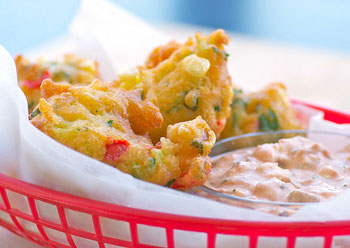 If there’s one thing I learned about food while living in North Carolina, it’s that anything can be battered and fried: steak, okra, pickles. Heck, even butter, as Paula Deen, proved, can be battered and fried.
If there’s one thing I learned about food while living in North Carolina, it’s that anything can be battered and fried: steak, okra, pickles. Heck, even butter, as Paula Deen, proved, can be battered and fried.
It’s not just Southerners though. Americans love battering and frying all types of foods. New Englanders have fried clams. Midwesternerns have fried pork. Southwesterners have fried chiles. Texans have fried Coca-Cola. Seriously.
Yet, of all these devilishly fried, crispy treats, corn fritters may just be the best. Tender sweet corn is encased in a pillow of sweet batter and fried until doubled in size and tantalizingly golden and crunchy.
With sweet corn season upon us, there is no better time to make Crispy Corn Fritters with Chipotle Cream Cheese Dipping Sauce. They’re impossibly simple to make and impossible to resist.
Coconut Ice Cream with Honey-Lime Strawberries
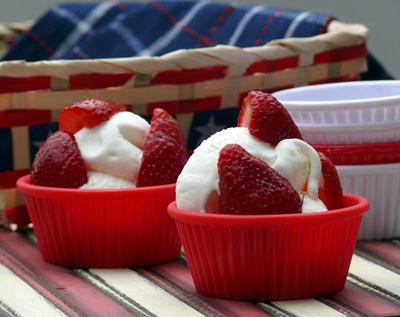 Homemade ice cream is a great tradition for the Fourth of July. Undoubtedly it hits the spot on a hot summer day. And we all know store bought ice cream is nothing compared to homemade.
Homemade ice cream is a great tradition for the Fourth of July. Undoubtedly it hits the spot on a hot summer day. And we all know store bought ice cream is nothing compared to homemade.
When I was sixteen I discovered my love of coconut frozen yogurt. Penguin’s Frozen Yogurt moved into my town and were looking for a bunch of teenagers to hire. It was a chain that was growing by leaps and bounds due to their popularity. After three…long…interviews I was hired. Can you believe three interviews for a job at a frozen yogurt place? Sheesh.
Anyway, coconut was a flavor we had maybe once a month. I loved it and it was all I would eat for the few days we had it. Since then I always seek out coconut ice cream…I never see it anywhere as coconut frozen yogurt…which is okay by me! I prefer ice cream.
So this ice cream…wow. Wow. Wow. It really is the best and there are so many possibilities of toppings, it make me dizzy just thinking about all of them.
How Long Is Your Rhubarb Season?
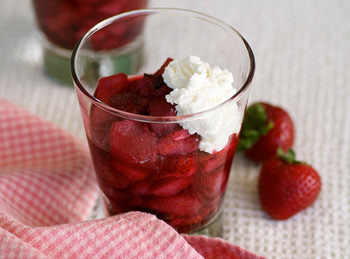 It's rhubarb season. Or is it?
It's rhubarb season. Or is it?
When I was a kid, rhubarb season was usually a couple of months long. You didn't have to buy it at the market because half of your neighbors grew it in their yards. I remember going to my great aunt's house where those crimson stalks stood at attention along the side of her house. I'd rip one right of the ground and bite into it like it was a carrot. I'd do it till my eyes watered, my lips went numb, and my belly turned sour. Ah, those were good days.
Nowadays, I have to rush to get my rhubarb fix. And rhubarb should not be rushed.
Since my belly isn't as steely as it used to be, I forego raw rhubarb for stewed, sweetened dishes like crumbles, crisps, and compotes. I have made many rhubarb compotes, but this one is special. The rhubarb is tempered by sugar and enhanced by freshly squeezed orange juice, aromatic ginger, and sweet blueberries.
Summer Quenchers: The Lemonade Variations
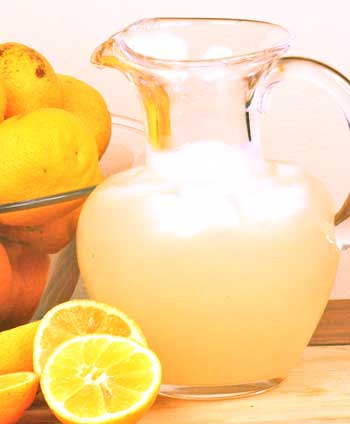 I’ve got this Meyer lemon tree in my yard that is dripping with fruit. With a sudden burst of culinary energy (for some reason I’m channeling Rachael Ray) I am doing a lemon project this week, finally committed to using my harvest for something other than dog toys.
I’ve got this Meyer lemon tree in my yard that is dripping with fruit. With a sudden burst of culinary energy (for some reason I’m channeling Rachael Ray) I am doing a lemon project this week, finally committed to using my harvest for something other than dog toys.
First, of course, I made lemonade. While I have often advised my kids (much to their irritation) to make lemonade out of lemons, I have rarely taken that advice myself, at least not literally. I had no idea how much sugar is in the stuff. No wonder it’s so addictive. Best rush since the Easter egg hunt.
I decided to make a couple of lemonade variations that would cut the sugar and add interest. Voila: Chamomile Arnold Palmers and Cucumber Mint Lemonade. Love that basic Meyer Lemonade, but if the sugar has you bouncing like a pinball, try one of its slightly less sweet cousins.
More Articles ...
Welcome to the new One for the Table ...
Our Home Page will be different each time you arrive.
We're sure you'll find something to pique your interest...


